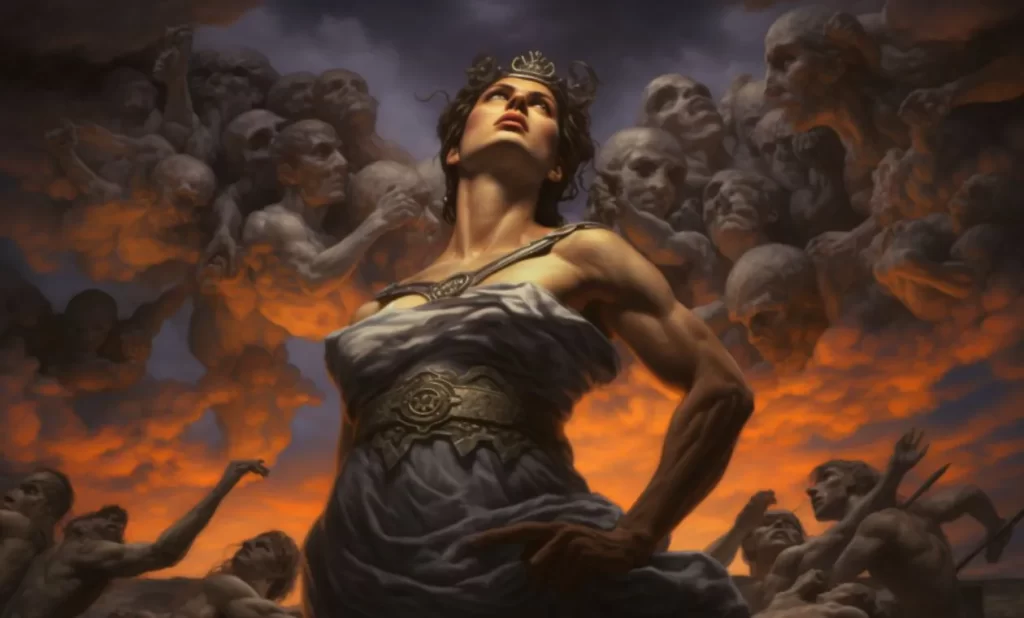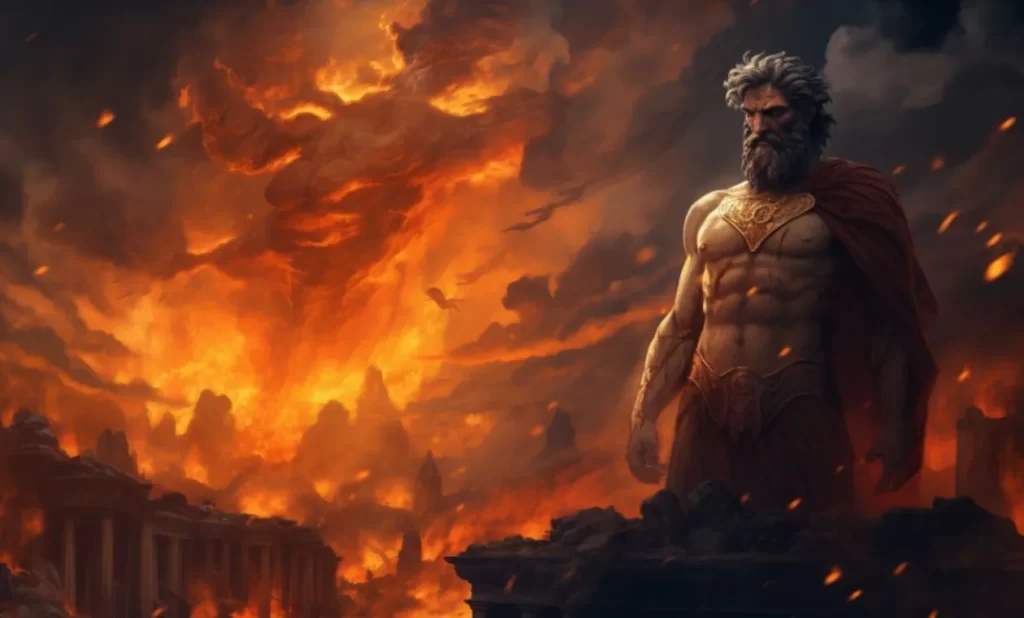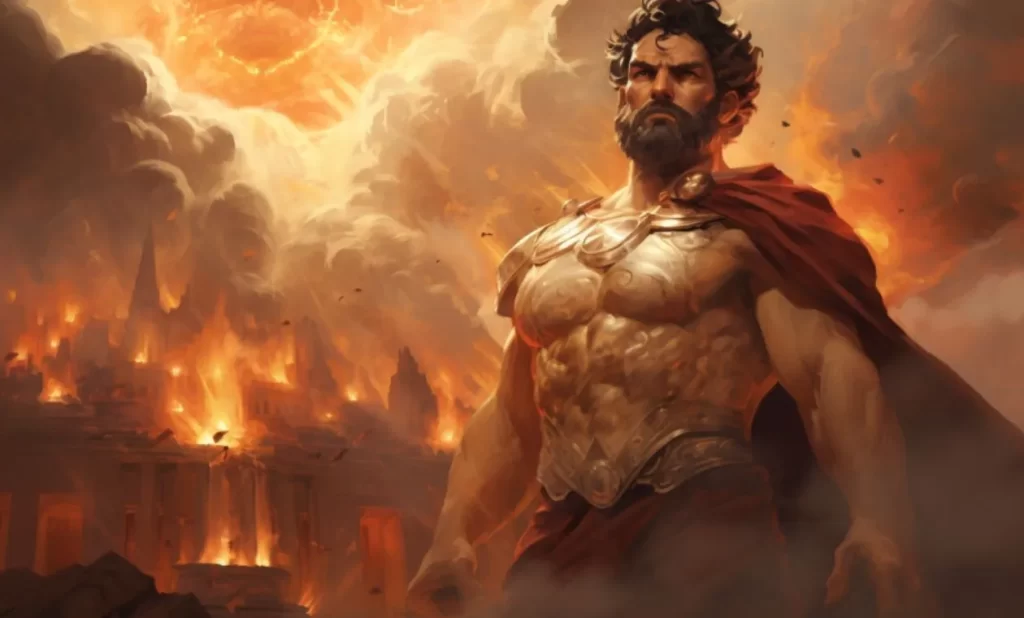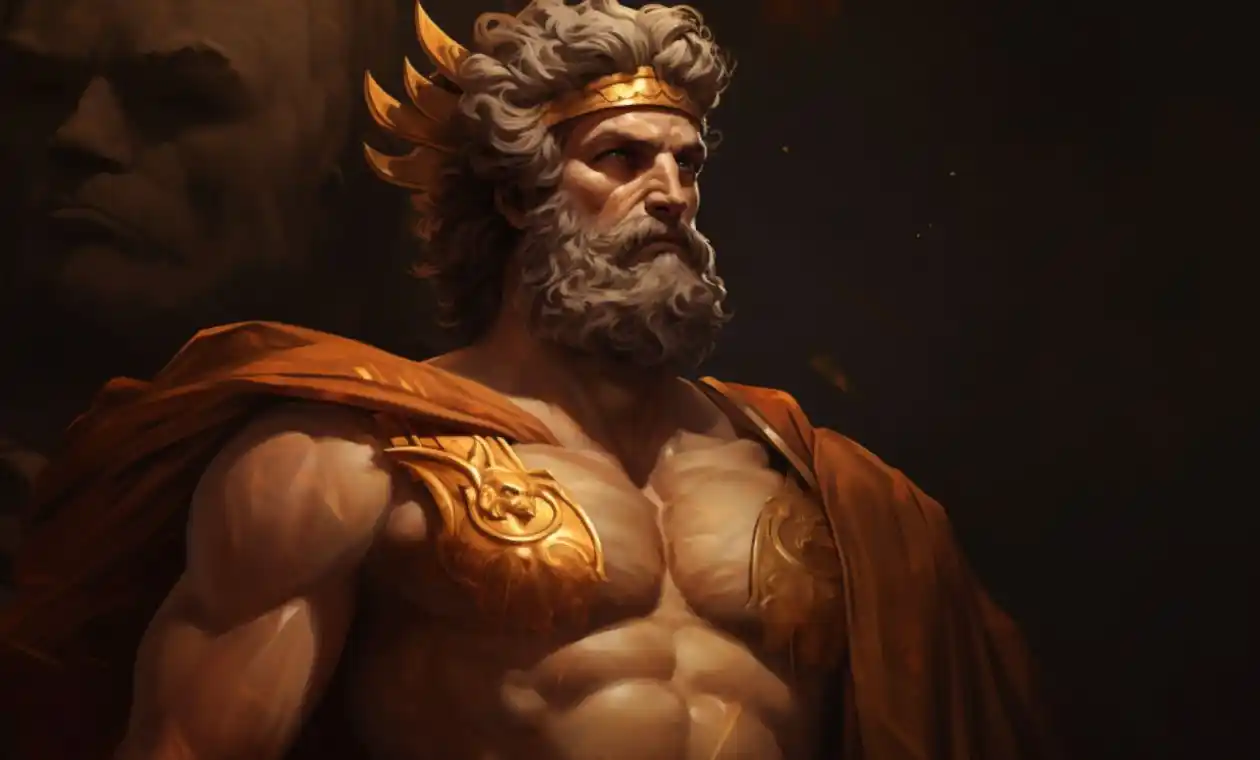
Once upon a time, in the sprawling palaces of heavenly Mount Olympus, a story began that would ignite imaginations for generations. This is the tale of Vulcan, the mighty god of fire and blacksmiths.
Vulcan’s birth was no ordinary event. Born to Jupiter, the king of gods, and Juno, the queen, he had an illustrious lineage. Yet, from the very beginning, his life was surrounded by drama and intrigue. Legend says that Juno, vexed with Jupiter for bearing a child (Minerva) on his own, decided to do the same. From her will alone, Vulcan was born. But, to Juno’s surprise and dismay, he was born with a limp. The gods on Mount Olympus, being vain and valuing perfection, didn’t know how to react to this. Some whispered, others pitied, and some even laughed.
The most heartbreaking part of the story is that his mother, Juno, repelled by his appearance, threw him off the heavenly mountain. As the legend goes, Vulcan descended for an entire day and night, finally crashing into the sea. Here, Thetis and Eurynome, sea nymphs, found him and cared for him for nine long years. It was on this isolated sea island that Vulcan began toying with metals, forging exquisite jewelry, and discovering his true passion and power – the mastery over fire.
One might ask, “How did Vulcan, cast away and rejected, become the god of fire?” Well, his rise was as meteoric as his fall was tragic. The very tools and trinkets he created on that island became his ticket back to Olympus. When Juno wore one of Vulcan’s necklaces, not knowing its creator, and everyone admired its beauty, she boasted about it. Upon realizing that Vulcan was the craftsman, she wanted more. Vulcan, clever as he was, agreed but on one condition – he be allowed back to Olympus. And so, Vulcan returned, not as an outcast, but as the revered god of fire and forge.
The Fiery Romance: Vulcan and Venus
In the very heart of Mount Olympus, where tales of passion and intrigue unfolded, there brewed a romance as unlikely as it was enchanting: the union of Vulcan, the god of fire, and Venus, the luminous goddess of love.
Venus, with her ethereal beauty, was the embodiment of desire and attraction. Every heartbeat, every stolen glance in the world below, was her doing. Her laughter could make flowers bloom, and her tears could cause them to wither. She was the shimmering morning star, the gentle touch of a lover’s hand, the soft whisper of a romantic song.
So, how did the fiery Vulcan, a god who worked with molten metals and roaring flames, come to be with the delicate Venus? It’s a tale that shows that even in the divine realms, love moves in mysterious ways.
When Vulcan returned to Olympus, he was a god transformed, not just in stature but in craft. His works were unparalleled, and many gods sought his favor. As a reward for his brilliance and also as a potential bond of peace, Jupiter, his father, offered him Venus’s hand in marriage. This union was intended to soothe the fiery temperament of Vulcan and keep Venus’s notorious affairs in check. The two, fire and love, were wed, creating an alliance of opposites.
But, why did Venus and Vulcan marry? Beyond the machinations of Jupiter, the union held deeper meaning. For Venus, Vulcan’s unwavering devotion offered a stability she rarely encountered. And for Vulcan, Venus brought warmth, not of the forge, but of the heart. Their marriage was a testament to the fact that love could be found in the most unexpected places, and that even the gods were not immune to the whims and wonders of the heart. It showcased the age-old truth that love, in all its forms, can melt even the hardest of barriers, even that of fire and steel.
Celebrating the Fire God: Vulcanalia Festival
In the bustling streets of ancient Rome, as summer reached its zenith, a unique celebration took place. Amidst the chirping cicadas and swaying golden fields, the Romans honored their god of fire, Vulcan. This event, full of fervor and festivity, was called the Vulcanalia festival.
The Vulcanalia wasn’t just another day on the Roman calendar; it held deep importance. Occurring on the 23rd of August, at the hottest time of the year, it was a day when fires were most likely to break out due to the scorching heat. And so, the festival was not only a celebration but also an appeal to Vulcan to keep destructive fires at bay.
On this day, large bonfires were lit. Romans would throw fish or small animals into the fire as a sacrifice, hoping to appease Vulcan and earn his favor. It wasn’t just about fearing his wrath; it was about acknowledging his power and seeking his protection. The flames that leapt skyward were seen as a bridge between the mortal world and the divine, carrying messages and offerings to the god above.
But what truly was the significance of the Vulcanalia festival?
In ancient Rome, the gods were deeply interwoven into daily life. They weren’t distant entities but integral parts of existence. The Vulcanalia, in essence, was a testament to humanity’s relationship with nature. By honoring Vulcan, the Romans showcased their understanding of the delicate balance of nature – the nurturing warmth of fire that cooked their food and forged their tools, against its potential for unchecked destruction.
The Sacred Space: Vulcan’s Forge

Deep within the belly of Mount Etna, away from the prying eyes of mortals and shielded from the other gods, there existed a space of raw magic and unparalleled craftsmanship: Vulcan’s Forge.
Picture a vast cavern, where roaring flames danced with shadows, casting a warm, golden glow upon the walls. At the center, a mighty anvil stood, having weathered countless strikes and having borne witness to the creation of artifacts of immeasurable power. Molten lava flowed like rivers, and metals of every conceivable kind gleamed in organized heaps, waiting to be transformed by Vulcan’s skilled hands.
This forge wasn’t just a workplace; it was Vulcan’s sanctuary. The rhythmic pounding of his hammer was his meditation, and with each strike, a new wonder was born. From delicate jewelry for Venus to the mightiest weapons for the gods of war, everything bore the unmistakable mark of Vulcan’s genius.
Why was the forge so pivotal to Vulcan’s essence? It was here that he healed from his traumatic fall from Olympus. While the sea nymphs cared for his wounds, it was the forge that mended his spirit. With every creation, he rebuilt his self-worth, making the forge not just a place of work but a realm of rebirth.
The forge symbolized the perfect union of raw power and refined skill. It was a testament to the idea that from pain and rejection could emerge beauty and strength. Every tool, every weapon, every trinket that emerged from it was a piece of Vulcan’s soul, a story of resilience, and a beacon of his immense power.
Powers Beyond Measure: Vulcan’s Abilities
In the pantheon of Roman gods, each deity held powers that set them apart, making them revered and sometimes even feared by mortals. Among them, Vulcan, with his fierce flames and skilled craftsmanship, stood as a beacon of transformative power.
Vulcan’s Incredible Powers:
- Mastery over Fire: Unlike others, Vulcan could control and manipulate fire. He could summon flames, douse them, and use them in whatever form he desired.
- Craftsmanship and Smithing: His most notable power was his unparalleled skill in crafting. From the most delicate of ornaments to the mightiest of weapons, he could forge them all.
- Immortality: Like other gods, Vulcan was ageless and immortal, untouched by the ravages of time.
- Physical Strength: While his limp might suggest otherwise, Vulcan possessed immense physical strength, making him formidable in any situation.
- Power of Protection: His creations often had protective qualities. They could shield, guard, or warn their bearers of impending dangers.
- Transformation: Using his forge, Vulcan could transform raw materials into objects of immense power and beauty.
Throughout Roman mythology, Vulcan’s influence was evident in numerous tales. His powers not only shaped events but also the fates of many characters, be they god or mortal.
But what artifacts did this master craftsman create?
Vulcan’s Notable Creations:
- Aegis for Jupiter: A protective cloak or shield, often bearing the head of Gorgon, that symbolized protection and power.
- Mars’ Weapons: Mars, the god of war, often wielded weapons forged by Vulcan, ensuring his victories in countless battles.
- Jewelry for Venus: To win over Venus and adorn his beautiful wife, Vulcan crafted exquisite pieces of jewelry, each a masterpiece in its own right.
- Armor for Aeneas: As mentioned earlier, the Trojan hero Aeneas was gifted a divine set of armor, ensuring his protection during his legendary quests.
- The Golden Throne Trap for Hera: In a tale of revenge against his mother Juno (Hera in Greek), Vulcan created a magical golden throne. When Juno sat on it, she was bound to the chair and couldn’t rise. Only after Bacchus intervened, Vulcan agreed to free her.
- Pandora: In some versions of the myth, Vulcan had a hand in crafting Pandora, the first woman, who was sent as a ‘gift’ but came with unforeseen consequences.
Vulcan, the Flamebearer: The Roman God of Fire
In the myriad tales that spun the tapestry of Roman mythology, few elements held as much significance as fire. It was a force of warmth, of transformation, of danger, and of divine essence. And at the helm of this force was Vulcan, the Flamebearer, guarding its secrets and wielding its might.
Vulcan’s Fiery Role:
As the primary deity of fire, Vulcan wasn’t just the guardian of flames; he represented the duality of fire itself. He embodied its nurturing aspect, the warmth that fended off the cold, the flames that cooked food, and the fires that forged tools and weapons. Yet, he also stood for its destructive nature, the infernos that could reduce cities to ashes and the uncontrolled blazes that could scorch the earth.
In the heart of Rome, where grand temples stood and where rituals marked the passage of time, Vulcan’s role was multifaceted. Blacksmiths, for whom fire was an essential tool, revered him as their patron. They sought his blessings to craft and create, hoping to mirror even a fraction of his divine skill. But beyond the forges, in homes and hearths, Vulcan was invoked for protection. As the protector against hazardous fires, households would offer prayers and small tokens in hopes that he would shield them from unexpected blazes.
Perception by Ancient Romans:
So, how was Vulcan perceived by the ancient Romans?
Vulcan was respected, perhaps with a tinge of fear. His limping figure, a reminder of his tumultuous origins, painted a picture of resilience. He was the god who transformed pain into purpose, turning personal tragedy into universal triumph. For the Romans, he wasn’t just a deity to be appeased, but also a symbol of the indomitable spirit, of rising from adversity, and of harnessing one’s potential.
Festivals like Vulcanalia were not just celebrations but were reminders of the god’s significance. They were occasions to show gratitude, seek protection, and remember the delicate balance of nature that Vulcan represented.
In the grand tapestry of Rome, with its legions and emperors, its gladiators and scholars, Vulcan held a special place. He was the Flamebearer, the guardian of one of nature’s most primal forces, and a testament to the idea that even in the face of great odds, brilliance could emerge from the ashes.
Crafting for Heroes: Aeneas’s Armor by Vulcan

Amid the vast lore of heroes and gods, legends and monsters, there stands a tale of a Trojan hero, Aeneas, whose destiny was intertwined with the foundation of Rome. As fate would have it, his journey was fraught with challenges, and his survival was paramount to the prophecies that foretold Rome’s grandeur. And ensuring this survival was a set of armor, not forged by mortal hands, but crafted in the divine forge of Vulcan himself.
Aeneas: The Trojan Protagonist
Aeneas, the son of the goddess Venus and the mortal Anchises, was no ordinary warrior. From the ashes of the fallen city of Troy, he emerged with a divine purpose: to seek a new homeland, which would eventually become the mighty Roman Empire. Yet, the path was not easy. Gods interfered, nature rebelled, and enemies lurked. He needed more than just courage; he needed divine protection.
The Divine Armor
Venus, ever the doting mother, was aware of the perils her son would face. She approached her husband, Vulcan, with a plea. Moved by his wife’s concerns and understanding the gravity of Aeneas’s mission, Vulcan agreed to craft a set of armor that would be unrivaled in its beauty and strength.
In the depths of his sacred forge, with fires hotter than ever before, Vulcan began his work. He molded the celestial metals, infused them with protective charms, and adorned them with intricate designs that told tales of past, present, and future events.
The shield, the centerpiece of this divine armor, was a masterpiece. It bore images of future Roman triumphs, prophecies that Aeneas was yet to understand. But each image, each engraving, held power. With this shield, Aeneas was not only protected physically but was also reminded of his grand destiny and the importance of his journey.
Vulcan’s Role in Aeneas’s Odyssey
The armor was more than just protective gear; it was a symbol of divine favor and a beacon of hope. With it, Aeneas faced enemies like the fierce warrior Turnus and survived events that would have otherwise been his end. It gave him the confidence to push through, to fight, and to establish what would become one of the greatest empires the world has ever known.
In crafting this armor, Vulcan did more than just provide protection; he cemented Aeneas’s place in history. Through this act, Vulcan showcased his essential role in the larger narrative, proving that behind every great hero’s success, there’s often a divine craftsman, ensuring their safety and guiding their path.
The First Woman: Pandora’s Connection with Vulcan
The annals of mythological tales brim with intriguing characters, but few have been as impactful and enigmatic as Pandora. Often cited as the first woman created by the gods, Pandora’s story intertwines curiosity, consequences, and cosmic design. Among the many divine fingerprints on her existence, Vulcan’s hand is often noted, marking yet another testament to the fire god’s reach into the affairs of mortals.
Pandora: A Gift and a Curse
In Greek mythology, Pandora was not born but crafted. In response to Prometheus’s theft of fire for humanity, Zeus, the king of the gods, decided on a unique form of retribution. He commissioned the creation of Pandora, the first woman, as both a gift and a potential doom for mankind.
Pandora was endowed with beauty and charm. Each god and goddess contributed something to her making – beauty from Aphrodite, persuasive charm from Hermes, and so forth. She was, in essence, a divine amalgamation, perfect in every way, yet also bearing a curiosity that would have fateful consequences.
Vulcan’s Role in Pandora’s Creation
Now, it’s essential to note that Pandora’s primary lore belongs to Greek mythology, where Hephaestus, Vulcan’s Greek counterpart, was instrumental in her creation. Hephaestus, known for his craftsmanship, molded Pandora from clay, breathing life into her form and thus creating the first woman.
While Roman myth doesn’t emphasize Pandora’s tale as much as Greek stories do, Vulcan’s connection to her is understood through this Greek counterpart, Hephaestus. In the Roman retelling, it’s often hinted that Vulcan, with his expertise in creation and craftsmanship, played a role similar to that of Hephaestus.
The Bond and Ramifications
Vulcan’s connection to Pandora wasn’t just about creation; it was symbolic. Just as fire, in the hands of humans, could be both a boon and a bane, Pandora, too, was a duality. Her curiosity led her to open the forbidden box (often called ‘Pandora’s Box’), releasing all evils into the world, leaving only hope trapped within.
Vulcan, the master of fire, thus became indirectly associated with this act. Just as he wielded and controlled flames, he also played a role in crafting a being whose actions would forever change the dynamics of the mortal world.
Pandora and Vulcan’s tales intertwine in a dance of creation, consequence, and cosmic intent, reminding us that even in mythology, actions ripple, stories intersect, and destinies are forged in the fires of divine design.
Places of Worship: Temples of Vulcan
Across the vast expanse of the Roman Empire, temples dotted the landscape, each a testament to the gods and goddesses that the Romans held dear. Among these places of worship, the temples dedicated to Vulcan stood as embodiments of respect and reverence for the god of fire and forge. They were sanctuaries where one could seek Vulcan’s blessings, offer gratitude, or simply marvel at the architectural prowess of the time.
Iconic Temples of Vulcan:
- Temple of Vulcan (Volcanal): Located in the Roman Forum, this ancient open-air altar, known as the Volcanal, was said to be one of the oldest sanctuaries in Rome. Legend suggests that it was constructed by Romulus himself after a fire was sent from the heavens by Vulcan. Over time, this sanctuary became a symbol of the symbiotic relationship between the Roman state and its deities.
- The Vulcanal in Pompeii: In the ruins of Pompeii, an ancient city preserved under volcanic ash, there’s an area referred to as the Vulcanal. It’s an open space dedicated to Vulcan, a fitting tribute given Pompeii’s tragic end due to the eruption of Mount Vesuvius.
Architectural Significance:
Vulcan’s temples, while not as ornate as some others, were uniquely designed to resonate with the god’s elemental nature. They often incorporated metals, fire basins, and forges, making them not just places of worship but also sites of craftsmanship. Stone and metalwork intertwined, hinting at Vulcan’s duality as both the god of destructive fire and creative forge.
Current Status of the Temples:
Over the centuries, many of the temples have succumbed to the ravages of time, war, and nature. However, some remnants persist, standing as silent witnesses to a bygone era.
- The Volcanal in the Roman Forum, while not entirely intact, has left behind traces. Archaeological excavations in the Forum have uncovered parts of the sanctuary, offering glimpses into ancient rituals and beliefs.
- The Vulcanal in Pompeii, preserved under layers of ash, provides a clearer picture. It remains a popular spot for tourists and history enthusiasts who visit the ruins.
Conclusion: The Everlasting Flame of Vulcan’s Legacy
In the vast pantheon of Roman deities, each god and goddess held a unique domain, a realm where their influence reigned supreme. Vulcan, with his forge and flames, commanded an elemental force, one that shaped civilizations, nurtured progress, and at times, wreaked havoc. Yet, while the Roman Empire has long since crumbled and the direct worship of these deities has faded into the annals of history, Vulcan’s legacy burns as brightly as ever.
Legacy in Modern Culture:
The very name “Vulcan” has left an indelible mark. Consider the term “volcano.” It’s derived directly from this god of fire, a reminder of the raw, untamed power he represented. Every time we witness the majestic and terrifying eruption of a volcano, we’re, in a way, seeing Vulcan’s power manifest.
Moreover, the stories of Vulcan have been woven into literature, art, and popular culture. From epic poems to modern adaptations, the tales of the god of fire, his tumultuous relationships, his incredible creations, and his fierce power, continue to captivate.
Timelessness of His Myths:
What makes Vulcan’s myths so timeless? Perhaps it’s the universal themes they tackle. His own origin story—a god cast out, finding purpose and power in adversity—resonates with anyone who has ever faced challenges or felt like an outsider. His tales touch upon love, betrayal, ambition, creativity, and the eternal balance between creation and destruction.
But beyond the tales, Vulcan epitomizes the spirit of craftsmanship and innovation. In a world where technology continues to evolve and where we, as a society, continually “forge” ahead into new frontiers, the ethos of Vulcan is ever relevant. He stands as a symbol of the transformative power of fire, both literal and metaphorical—the fire of passion, the fire of innovation, and the fire of resilience.
Related Article –
























